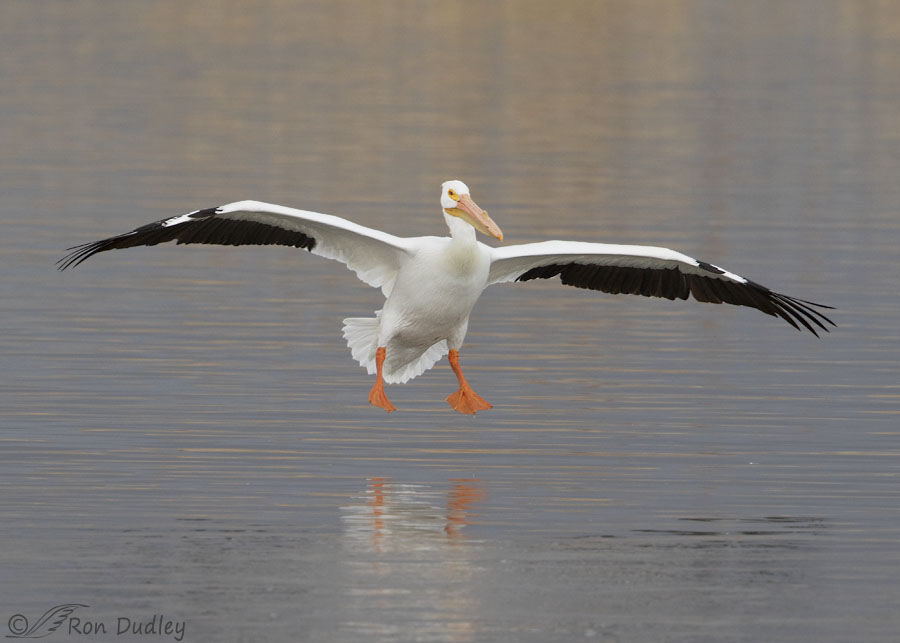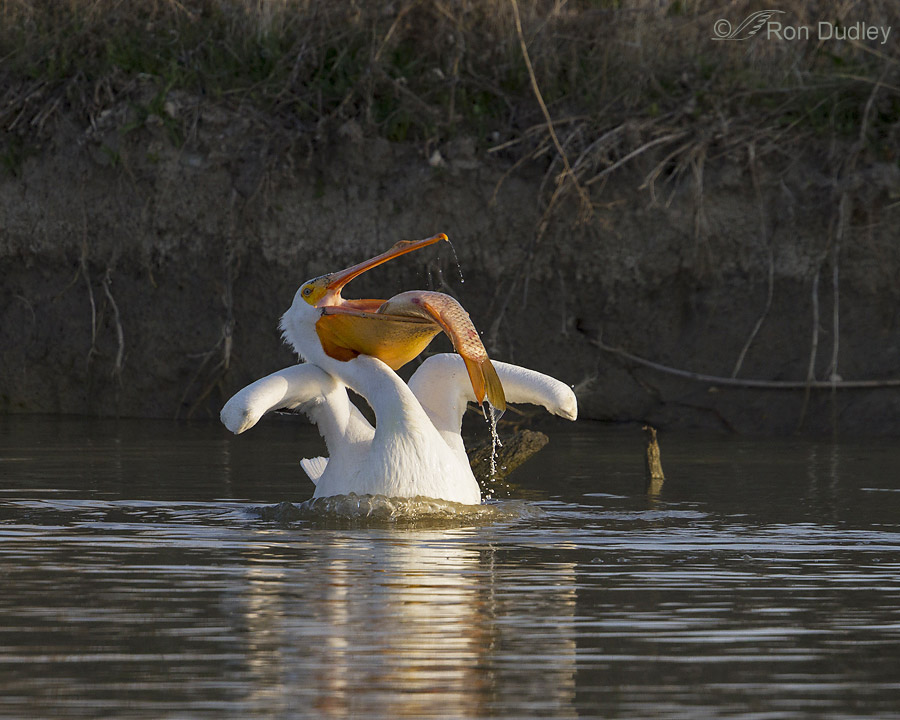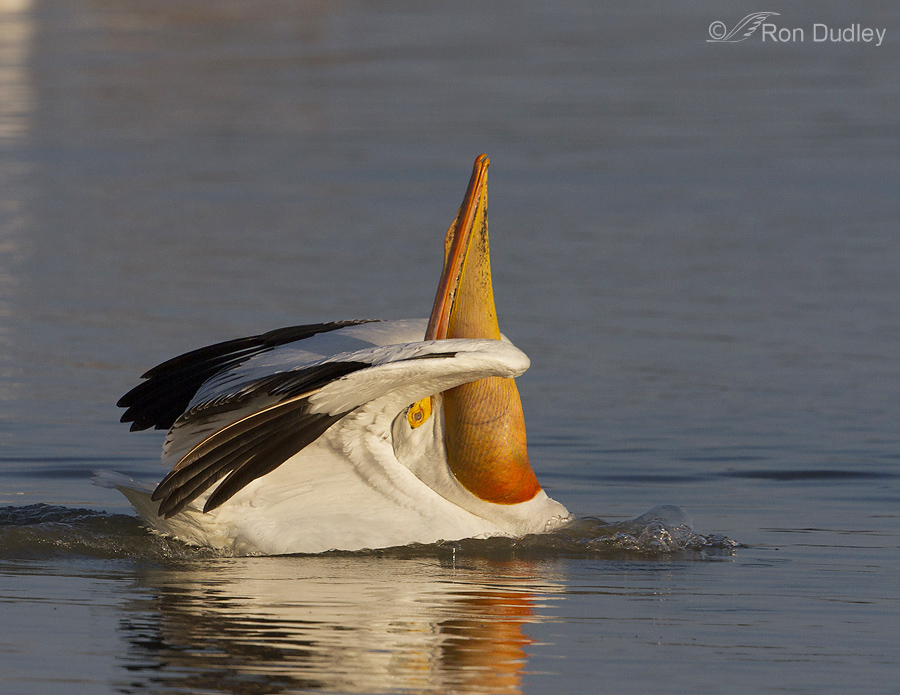Our famous Gunnison Island American White Pelican rookery is in big trouble.

Utah is well known for its American White Pelicans, in no small part because of the pelican rookery on Gunnison Island in a remote part of the Great Salt Lake. During nesting season Gunnison Island is home to up to 20,000 pelicans estimated to be 10 – 20% of the entire population of the species. In a typical breeding season 4000 – 5000 pelican youngsters fledge on Gunnison Island.
Since the Great Salt Lake has no fish because it’s too salty the obvious question is… what do they eat? Each day many of the adult pelicans fly 30 miles east, especially to Bear River Migratory Bird Refuge, where the salinity is much lower and fish are abundant. Some of the adults actually fly about 100 miles south to Utah Lake in order to load up on fish. Both groups then return to the rookery to feed their youngsters.
This explains why people see those huge flocks of pelicans circling high overhead with their blacks and whites flashing in the morning sun. In order to save energy for the long daily trips they ride thermals to great heights then largely coast down to their destination.

In many areas of the country the adults typically eat small fish but at Bear River MBR carp are common and can be quite large. This pelican struggled mightily to get the big carp down the hatch but “his” efforts were complicated by other pelicans out of frame that kept trying to steal it.

He worked at swallowing the carp for a long time but I believe he eventually gave up, It was just too big. Here we can actually see the scales of the carp through the thinly stretched membrane of the pelican’s pouch. I always marvel at the effort and energy required to fly such big loads of fish all the way back to the rookery.
The Gunnison Island rookery is threatened for three related reasons – low water levels of the lake, predators and short-sighted and selfish humans. Gunnison Island is close to the shore and in shallow water. When water levels drop due to natural or not so natural water fluctuations the island becomes connected to the shore by a land bridge so predators like coyotes can take advantage of the extremely vulnerable pelican chicks on the ground. And they do.
In recent years water levels of the lake have been dropping precipitously, partly because of drought but even more so because of overuse of fresh water entering the “dead” lake. Thanks to a coalition of selfish and short-sighted politicians, industrialists and agricultural interests much of the fresh water that has naturally entered the lake for centuries is being diverted for use by industry and agriculture so the lake is drying up. Even with the lake already disappearing politicians have proposed additional dams and impoundments on the Bear River. The lake and the pelicans and other birds that rely on it don’t have a chance. The iconic Bear River Migratory Bird Refuge is seriously threatened.
Last year, largely because of low water levels exposing the land bridge and allowing predators like coyotes onto the island the typical 4000-5000 young pelicans raised to fledging was reduced to no more than 500. And something similar is likely to occur again this year and on down the road until the rookery completely collapses.
I’ve always wanted to be one of the volunteers that helps Utah DWR band young pelicans on the island just before they fledge. Several friends of mine, including a couple of my ex-students, have done it but I never have. If you’d like to get a feel for what it’s like, and for the effect of the land bridge being exposed has had on pelican numbers, please watch this video clip of last year’s banding operation.
It will definitely open your eyes.
Ron


It is tragic, and our Dear Leader is leading the charge, convincing his loyal followers that wetlands are nothing but “mudholes” in someone’s back yard and they have to go through hell to get permits to fill them. Don’t people wonder why the rivers keep flowing even when it not raining? Our local small heron rookery along a drainage canal was finally extinguished this year. It formerly had 8-10 pairs of Yellow-crowned Night-Herons and 3-5 pairs of Green Herons, also Anhingas and a pair of Black-crowned Night-Herons until a campaign of herbicide application and removal of all tree limbs which hung over the water (of course these are the favored nesting sites) was launched by the Drainage District in response to Hurricane Irma almost three years ago. They feared that the canal could be blocked by falling limbs, even though there was no evidence of this during this or any prior hurricanes. I could rant on…
Hiss and effing spit.
Yep, and that is all I can say about that…….
Yep is enough.
Ron, this is so upsetting to hear. As we both share our loves for BRBR it is upsetting to hear and see the water levels so low this year. It is no doubt to me how much impact it can carry. I hope there can be some level of improvement.
Khysen and I have participated with the DWR on goose banding, but never on pelican banding. That would be equally if not more exciting then the goose banding! I will have to look into this for the family.
I just watched the video you linked and it about had me in tears. Not good 🙁
Nope, not good at all, Shane. It’s deeply disturbing.
Astounding photo of the scales showing through.
Bird declines, water usage, greed, bureaucracy. What comes after the Anthropocene, the Recoverocene?
Good question, Lyle. Or perhaps the Toolateocene…
What prevents F&W from fencing off the access to the island? There must be some way to prevent or discourage predators and humans from accessing the island even at low water?
“What prevents F&W from fencing off the access to the island?”
Well, I’ve yet to see a fence that would stop a coyote. Or most other predators. Humans accessing the island hasn’t been much of a problem since it’s illegal and the island is so very remote.
Amen to “trying” to fence out a Coyote! 🙁
Very interesting post Ron. Most years here in Prescott we get the White American Pelicans here in March or April on their way to Gunnison. Usually about 150 and they only stay for one day and an overnight and then by late morning the following day they are gone. And then in October and November we are usually fortunate to get a small group of close to ten that will just hang out here for those two months to the delight of all our birding folks.
It will be a real shame if they are forced to improvise and find new breeding grounds due to what is happening there in Utah.
In the past I have reported tagged Pelicans here via the system to do so and have enjoyed receiving personal thank you e-mails from the very persons who originally tagged them.
Your post has much information I was not aware of such as the fact that they have to fly off to other locations to find fish.
Do you know how many years the Pelicans have been coming to Gunnison Island to breed?
Nope, I don’t know, Everettt – but my bet would be hundreds, perhaps thousands of year. They breed there to escape predators of their chicks and predators have been around for a while…
There has been a marked decrease in the number of pelicans coming to the Forest Dale Golf course pond this year. In the past I have seen them every day coming, fishing and going. This year I have only seen five. Being home so much more has not increased the number of sightings but decreased my numbers. Sad to contemplate.
Can you hear me screaming? Humans are a scourge on the Earth, a life-sucking parasite Mother Nature needs to at least cull if not eliminate!! Perhaps that’s what this virus is all about? Yes, I’m a heretic. Go with it!
White pelicans, doing that amazingly elegant flock thing, kept me (relatively) sane while I was recovering from surgery on both feet when I lived in Dallas. The pelicans hung out at White Rock Lake and my significant other at the time would load me in the car to witness that utter magic. Imagine humans trying that kind of precision–oh yeah, we do with rush-hour traffic. That usually doesn’t turn out all that well since we mostly suck at species cooperation as witnessed by our reactions to this social distancing/mask-wearing thing. And then there was yesterday’s news. I really need to stop listening since my head and heart are about to explode in sorrow and grief. I’m mostly ashamed of my species now. When will we learn that we’re SHARING this planet with other beings and they have the same right to exist as we do!!
Let me share a quote with you. “There is nothing in which the birds differ more from man than the way in which they can build and yet leave a landscape as it was before.” Robert Wilson Lynd
Sorry–up on my soap box again.
I agree with and applaud you Laura for your post. I have the same philosophy about Mother Nature and wild life.
Unfortunately, the current culling process by Mother Nature doesn’t seem to be culling those who could most benefit from it……. 😉 I’m bad….. 😉
Bad perhaps, but right.
Lynd nailed it, didn’t he Laura.
I am up there with you. Screaming, weeping, raging. Despairing.
I’m sorry to hear about this. When will we ever learn? Too late for many animals and natural spaces, I fear.
“When will we ever learn?”
Don’t hold your breath in that regard, Cathy.
Reminds me of the song “Where Have All The Flowers Gone…..”
Yes, Judy! I was thinking of The Byrds at first, but of course Peter, Paul & Mary and others did the same song …
Sad to see. We have about 4,000 nesting pairs that return here to the islands in the Bay of Green Bay. What a joy to watch them fishing…we see them on just about all the waters in the area. Watching large pods of them herd fish in a circle for feasting is a sight! Smart way to get your meal for all!
Kathy, I hope your nesting colonies remain viable, in contrast to our failing rookery on Gunnison Island.
Amazing the Pelican didn’t choke! Nature has it’s course and changes BUT our input – or rather “taking away” sure helps screw things up. Then “someone” will decide they need to do something else ridiculous to mitigate the problem humans created……. Sighhhhhhh
Yup, that’s about it, Judy.